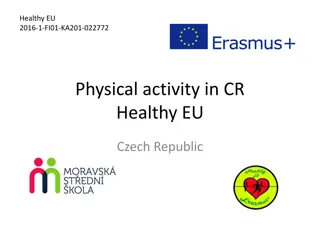Understanding the Difference Between Exercise and Physical Activity
In this informative content, Professor Sandy Jack explains the distinction between physical activity and exercise. Physical activity involves any movement requiring energy, while exercise is intentional, structured movement aimed at improving or maintaining physical fitness. The evidence supports the importance of recognizing this difference, especially in healthcare settings like cancer diagnosis and treatment pathways. Recommendations emphasize integrating exercise for individuals with cancer diagnoses to improve physical fitness and overall health.
Download Presentation

Please find below an Image/Link to download the presentation.
The content on the website is provided AS IS for your information and personal use only. It may not be sold, licensed, or shared on other websites without obtaining consent from the author. Download presentation by click this link. If you encounter any issues during the download, it is possible that the publisher has removed the file from their server.
E N D
Presentation Transcript
What is the difference between exercise and physical activity and what does the evidence tell us? Sandy Jack Professor of Prehabilitation Medicine, Clinical Experimental Sciences, Faculty of Medicine, University of Southampton
Physiological Reserve PHYSICAL FITNESS ACTIVITY EXERCISE
Physiological Reserve Physical activity = movement that is carried out by the skeletal muscles that requires energy. Exercise = planned, structured, repetitive and intentional movement intended to improve or maintain physical fitness. PHYSICAL FITNESS ACTIVITY EXERCISE
Physiological Reserve Frailty = a distinctive health state (related to the ageing process) in which multiple body systems gradually lose their in-built reserves. FRAILTY PHYSICAL FITNESS
Physiological Reserve Sarcopenia = degenerative loss of muscle mass, quality and strength SARCOPENIA FRAILTY PHYSICAL FITNESS
Physiological Reserve SARCOPENIA FRAILTY ACTIVITY EXERCISE
Physiological Reserve SARCOPENIA FRAILTY ACTIVITY EXERCISE
Physiological Reserve SARCOPENIA FRAILTY ACTIVITY EXERCISE
Macmillan/RCoA/NIHR Guidance on Exercise Interventions Statement 1: Health and care professionals should understand and communicate the important difference between physical activity and exercise. Strength of Recommendation = Strong, Level of Supporting Evidence = A Statement 2: Exercise should be integral to care for all people with a cancer diagnosis, starting as early as possible. Strength of Recommendation = Strong, Level of Supporting Evidence = A Statement 3: All people with a cancer diagnosis should have a validated physical fitness screen as early as possible in their treatment pathway Strength of Recommendation = Weak, Level of Supporting Evidence = B Statement 4: People with a cancer diagnosis who are less physically fit should undergo a comprehensive evaluation to inform the prescription of a supervised exercise programme as early as possible. Strength of Recommendation = Strong, Level of Supporting Evidence = B 10
Statement 5: Supervised exercise programmes are more effective than unsupervised programmes at improving physical fitness before surgery. Strength of Recommendation = Strong, Level of Supporting Evidence = B Statement 6: Exercise programmes should be prescribed by a professional qualified in exercise prescription with relevant experience in cancer care. Strength of Recommendation = Strong, Level of Supporting Evidence = A Statement 7: Exercise programmes for people with a cancer diagnosis should be delivered by appropriately trained individuals. Strength of Recommendation = Strong, Level of Supporting Evidence = C Statement 8: A validated measure of physical fitness should be used to monitor the effectiveness of an exercise prehabilitation intervention for people undergoing cancer treatment. Strength of Recommendation = Strong, Level of Supporting Evidence = A 11
s.jack@soton.ac.uk wesfit.org.uk @WesFit_trial SafeFit.nhs.uk @SafeFit_Trial 12























